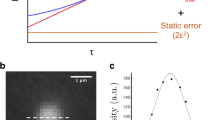Abstract
Probing the physical properties of heterogeneous materials is essential to understand the structure, function and dynamics of complex fluids including cells, mucus, and polymer solutions. Particle tracking microrheology is a useful method to passively probe viscoelastic properties on micron length scales by tracking the thermal motion of beads embedded in the sample. However, errors associated with active motion have limited the implementation to dynamic systems. We present a simple method to decouple active and Brownian motion, enabling particle tracking to be applied to fluctuating heterogeneous systems. We use the movement perpendicular to the major axis of motion in time to calculate rheological properties. Through simulated data we demonstrate that this method removes directed motion and performs equally well when there is no directed motion, with an average percent error of <1%. We use this method to measure glycerol–water mixtures to show the capability to measure a range of materials. Finally, we use this technique to characterize the compliance of human sputum. We also investigate the effect of a liquefaction agent used to prepare sputum for diagnostic purposes. Our results suggest that the addition of high concentration sodium hydroxide increases sample heterogeneity by increasing the maximum observed creep compliance.






Similar content being viewed by others
References
Alam, M. M., and R. Mezzenga. Particle tracking microrheology of lyotropic liquid crystals. Langmuir 27:6171–6178, 2011.
Baker, E. L., R. T. Bonnecaze, and M. H. Zaman. Extracellular matrix stiffness and architecture govern intracellular rheology in cancer. Biophys. J. 97:1013–1021, 2009.
Crocker, J. C., and B. D. Hoffman. Multiple-particle tracking and two-point microrheology in cells. Methods Cell Biol. 83:141–178, 2007.
Dangaria, J. H., S. Yang, and P. J. Butler. Improved nanometer-scale particle tracking in optical microscopy using microfabricated fiduciary posts. Biotechniques 42:437–440, 2007.
Dawson, M., D. Wirtz, and J. Hanes. Enhanced viscoelasticity of human cystic fibrotic sputum correlates with increasing microheterogeneity in particle transport. J. Biol. Chem. 278:50393–50401, 2003.
Gal, N., and D. Weihs. Intracellular mechanics and activity of breast cancer cells correlate with metastatic potential. Cell Biochem. Biophys. 63:199–209, 2012.
Hasnain, I. A., and A. M. Donald. Microrheological characterization of anisotropic materials. Phys. Rev. E 73:031901, 2006.
Isenberg, H. D. Essential Procedures for Clinical Microbiology. Washington: ASM Press, p. 851, 1998.
Jindal, S. K. E. Textbook of Pulmonary and Critical Care Medicine (2 Vol). London: JP Medical Ltd, p. 2296, 2011.
Kent, P. T., and Centers for Disease Control (U.S.). Public health mycobacteriology: a guide for the level III laboratory. Atlanta, GA: U.S. Dept. of Health and Human Services, Public Health Service, Centers for Disease Control, 207 pp, 1985.
Lai, S. K., Y.-Y. Wang, R. Cone, D. Wirtz, and J. Hanes. Altering mucus rheology to “solidify” human mucus at the nanoscale. PLoS ONE 4:e4294, 2009.
Lai, S. K., Y.-Y. Wang, D. Wirtz, and J. Hanes. Micro- and macrorheology of mucus. Adv. Drug Deliv. Rev. 61:86–100, 2009.
Mason, T. G., K. Ganesan, J. H. van Zanten, D. Wirtz, and S. C. Kuo. Particle tracking microrheology of complex fluids. Phys. Rev. Lett. 79:3282–3285, 1997.
Pelletier, V., N. Gal, P. Fournier, and M. Kilfoil. Microrheology of microtubule solutions and actin-microtubule composite networks. Phys. Rev. Lett. 102:100–103, 2009.
Qian, H., M. P. Sheetz, and E. L. Elson. Single particle tracking. Analysis of diffusion and flow in two-dimensional systems. Biophys. J. 60:910–921, 1991.
Rogers, S. S., T. A. Waigh, and J. R. Lu. Intracellular microrheology of motile Amoeba proteus. Biophys. J. 94(8):3313–3322, 2008.
Savin, T., and P. S. Doyle. Static and dynamic errors in particle tracking microrheology. Biophys. J. 88:623–638, 2005.
Savin, T., and P. S. Doyle. Statistical and sampling issues when using multiple particle tracking. Phys. Rev. E 76:021501, 2007.
Squires, T. M., and T. G. Mason. Fluid mechanics of microrheology. Annu. Rev. Fluid Mech. 42:413–438, 2010.
Steingart, K. R., V. Ng, M. Henry, P. C. Hopewell, A. Ramsay, J. Cunningham, R. Urbanczik, M. D. Perkins, M. A. Aziz, and M. Pai. Sputum processing methods to improve the sensitivity of smear microscopy for tuberculosis: a systematic review. Lancet Infect. Dis. 6:664–674, 2006.
Tseng, Y., T. P. Kole, and D. Wirtz. Micromechanical mapping of live cells by multiple-particle-tracking microrheology. Biophys. J. 83:3162–3176, 2002.
Valentine, M. T., P. D. Kaplan, D. Thota, J. Crocker, T. Gisler, R. K. Prud’homme, M. Beck, and D. A. Weitz. Investigating the microenvironments of inhomogeneous soft materials with multiple particle tracking. Phys. Rev. E 64:061506, 2001.
Weihs, D., M. A. Teitell, and T. G. Mason. Simulations of complex particle transport in heterogeneous active liquids. Microfluid. Nanofluid. 3:227–237, 2006.
Wirtz, D. Particle-tracking microrheology of living cells: principles and applications. Annu. Rev. Biophys. 38:301–326, 2009.
DOW. Glycerine: Viscosity.
Yamada, H., S. Mitarai, L. Aguiman, H. Matsumoto, and A. Fujiki. Preparation of mycobacteria-containing artificial sputum for TB panel testing and microscopy of sputum smears. Int. J. Tuberc. Lung Dis. 10:899–905, 2006.
Acknowledgments
The authors would like to thank Prof. Bela Suki for helpful comments on the manuscript. The authors thank Suchismita Paul for access to sputum samples. The research was in part was supported by funding from the Harvard University Center for AIDS Research (CFAR), an NIH funded program (P30 AI060354) to D.B.T and the United States Army Medical Research Acquisition Activity under Grant W81XWH-10-2-0161 to S.M.F and NIH grant (1 RC2 CA147925) to MHZ.
Author information
Authors and Affiliations
Corresponding author
Additional information
Associate Editor Michael R. King oversaw the review of this article.
Rights and permissions
About this article
Cite this article
Fong, E.J., Sharma, Y., Fallica, B. et al. Decoupling Directed and Passive Motion in Dynamic Systems: Particle Tracking Microrheology of Sputum. Ann Biomed Eng 41, 837–846 (2013). https://doi.org/10.1007/s10439-012-0721-2
Received:
Accepted:
Published:
Issue Date:
DOI: https://doi.org/10.1007/s10439-012-0721-2




